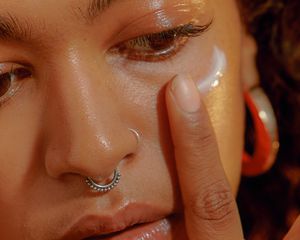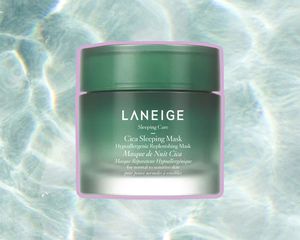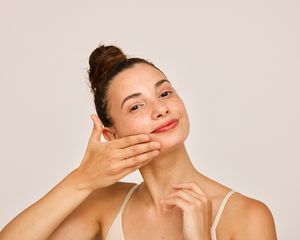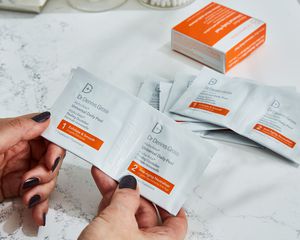
Liz DeSousa / Byrdie
Writing this story brings back so many memories. Before I was a beauty editor, I had a thing for going to beauty counters and drugstores to purchase the latest and greatest skincare drops. Scrubs, physical exfoliators, cleansers, etc.—you name it, I bought it. However, I tried all these different products simultaneously. After a few days, my skin would be irritated, broken out, and in one extreme case, burned, all in the name of ridding myself of hyperpigmentation.
Well, I can report that I made matters worse and set my skincare journey back. I want you all to learn from my mistakes and heed the advice of skincare professionals, not just what you see when scrolling on your social media app of choice. So I went to the professionals—board-certified dermatologists Loretta Ciraldo, MD, FAAD, and Hadley King, MD, FAAD—to get the deets on what over-exfoliated skin symptoms can look like and how to care for over-exfoliated skin at home. Read on for what they had to say.
Meet the Expert
- Loretta Ciraldo, MD, FAAD, is a Miami-based board-certified dermatologist with over 40 years of experience and the founder of Dr. Loretta Skincare.
- Hadley King, MD, FAAD, is a New York City-based dermatologist.
What Is Over-Exfoliated Skin?
As a former weekly over-exfoliator, I can tell you from experience that your skin will let you know when you've overdone it with physical indicators. We'll get to that in a sec. But let's talk about healthy exfoliation first because using actives to remove dead skin isn't all bad. "Healthy exfoliation removes excess dead cell buildup at the skin surface and in pores," says Ciraldo.
However, she notes things get tricky when we start doing whatever we want to our skin without thoughtfulness and care—and that chemical exfoliator you leave on beyond the time it states on the bottle can be part of the problem. "If we use an overly aggressive exfoliating agent, apply too much, or leave it on for too long, it can remove a healthy amount of dead cells and the healthy skin oils that reside between them, resulting in a compromised skin barrier and over-exfoliated skin."
Signs and Symptoms of Over-Exfoliated Skin
- Redness: Over-exfoliated skin can start with redness of the skin.
- Dehydrated, dry skin: Dry skin isn't just a product of the change in weather. If you over-exfoliate, you may find you have dry patches and skin that is flaking off of the face.
- Peeling or burning: There's a misconception that skin burning equals a product working. In fact, it's the opposite. Peeling and burning means the skin barrier is likely disrupted. "A healthy skin barrier is important for skin luminosity, smooth texture, and to prevent irritation and redness," Ciraldo shares. "Factors that can damage the healthy skin barrier include dermatitis, aging, and irritating actives in our skincare products, including but not limited to exfoliants."
- Small pimples: Those tiny pimples cropping up aren't skin purging—they're your skin telling you you've overdone it.
What Causes Over-Exfoliated Skin?
Now that we know what to look for, let's talk about the causes of and how to avoid over-exfoliation. We know chemical exfoliants and retinol are excellent treatments for everything from fine lines to hyperpigmentation. Still, there are some things to think about as you add them to your routine.
For example, if you're just starting out using actives, Ciraldo says that retinol and acids that are too concentrated can cause over-exfoliation. "Generally, it is good to start with an AHA in the 5-10 percent range and to use it only every other night or even just once the first week if you have sensitive skin," she advises. As for physical exfoliators, which we know are controversial in the world of skincare, she recommends doing your research. For example, seek out online product reviews and take inventory of the ingredient lists to ensure products aren't using harsh particles like ground fruit pits and shells.
How to Treat Over-Exfoliated Skin
So you've overdone it on the exfoliation, and your skin is angry. Now what? Double down? Absolutely not. I'm talking to my former self here, too. Put down the actives, exfoliants, and anything that could potently stimulate the skin. It's time for an easy, breezy, hydrating, and calming routine with a gentle cleanser and basic moisturizer with skin-loving ingredients.
If you're a skincare enthusiast and don't have Aquaphor in your arsenal, run, not walk, to the drugstore, because it's a lifesaver for everything from irritated skin to chapped lips. For peeling, red, and ultra-sensitive skin, Ciraldo recommends Aquaphor's Anti-Itch Ointment ($14). "It is 1 percent hydrocortisone in the healing Aquaphor base, so it improves redness as well as dryness and peeling. [Additionally,] if you are peeling but not sensitive or very red, I recommend the Dr. Loretta Intense Replenishing Serum ($70) with multiple healthy skin oils, including glycolipids, linolenic, and vitamin E, and antioxidant Lipochroman and brightening active Chromabright."
Additionally, King recommends humectants to hydrate the skin, emollients to support the skin barrier, and occlusives to lock in moisture. "Emollients are particularly important to help repair the skin barrier— think ceramides, triglycerides, squalane, fatty acids, fatty alcohols, etc.," she tells us.
When to See a Physician
Seeing and feeling your skin at its worst can be alarming, but don't freak out. Your skin knows how to heal itself if you allow it. To monitor how your skin healing process is going, Ciraldo suggests taking photos daily to see if your symptoms are improving or worsening. If they aren't getting better after you've stopped all irritants, our expert dermatologists recommend scheduling time with a professional.
















